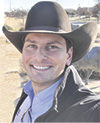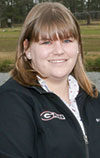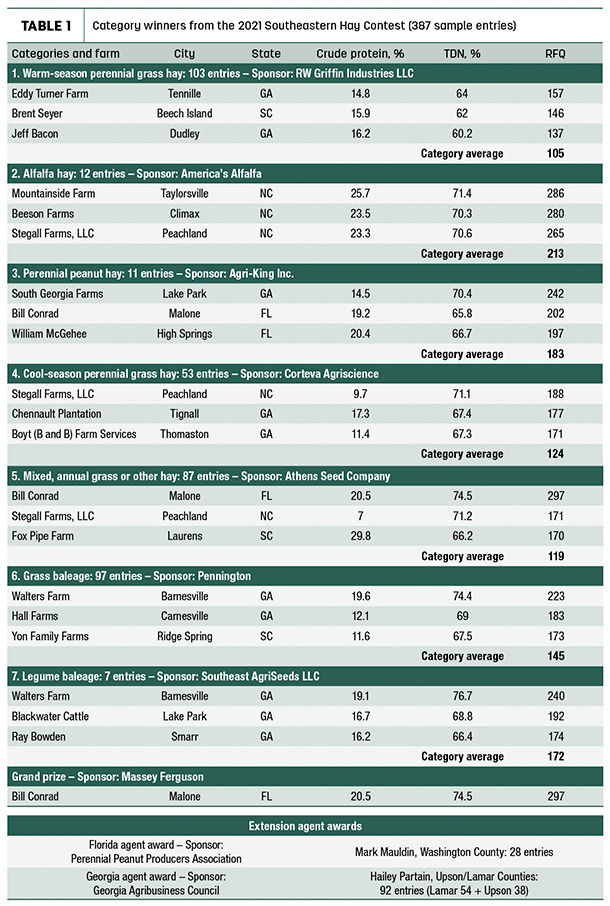What does it mean to have good-quality hay? Well, here in the Southeast means you can get some nice prizes and a lot of recognition. That is what the Southeastern Hay Contest (SEHC) has been proudly doing for 17 years, recognizing the effort put by our farmers on producing good-quality hay.
And what a challenging year to produce hay. Heavy rains in the eastern Coastal Plains, multiple storms coming through the Gulf and some dry weather in the western side of the region. But our farmers are resilient and persistent. After all, our livestock must eat, and good hay needs to be put up. In a year when commodity and energy prices are high, good-quality hay can be the difference between profit and losses, in high pregnancy rates and weaning weights, or a failed production cycle. Most farmers will need to cut back on supplementation protocols as feed prices soared, and fine-tuning supplementations to the exact needs and no waste will be ever more important this winter. And the only way to be able to achieve that is by getting a hay analysis. This is the mission of the hay contest: bring awareness to the importance of hay testing and of managing feed demands based on quality.
The SEHC gets into its 17th edition with a record number of entries (387) coming from nine out of the 13 states in the Southeast region. Moreover, we have seen some of the highest relative forage quality indexes (RFQ) ever. Producers can enter the SEHC in seven categories of hay and baleage: warm-season perennial grass hay (bermudagrass, bahiagrass), alfalfa hay, perennial peanut hay, perennial cool-season grass (tall fescue, orchardgrass, etc.) hay, mixed and annual grass hay, grass baleage and legume baleage. The samples are ranked based on RFQ, and the top three entries in each category receive a cash prize. The overall winner also receives a choice of the use of a new Massey Ferguson DM Series disc mower or RK series rotary rake for the 2022 hay production season plus $1,000 in cash. This year’s winners are presented on Table 1. Our top prize goes to Bill Conrad, in Malone, Florida, with a crimson clover hay that almost broke the scale at an RFQ of 297. The award ceremony went back to the traditional stage at the Sunbelt Ag Expo, where winners were announced on Oct. 19, 2021.
Click here or on the table above to view it at full size in a new window.
We had other great achievements. Our year started with a hay workshop at the American Forage and Grassland Council annual conference in Savannah, Georgia; and in September, we had our first SE Hay Short Course in Lake City, Florida. As our reach increases, so does our commitment to education, and we plan on keep bringing to farmers in different regions great programs and materials on hay production and feeding. The SEHC is possible because of the effort of our extension agents, who engage producers and collect samples, and because of our sponsors, who support each of the categories. This year, we received samples from Georgia, Florida, Virginia, North Carolina, South Carolina, Mississippi, Alabama, Arkansas and Tennessee. We are still missing a few states in the Southeast, and that is the challenge for the 2022 Southeastern Hay Contest: to have least one sample from each of the 13 states. Be the first or keep the tradition, prove your hay is the best. Submissions are open year-round; check the website for more information, or contact your local county agent or forage extension specialist. The SEHC is a partnership between cooperative extension and private industry, who make this event possible.
What is relative forage quality?
RFQ is an index used to represent different forages relative to their overall nutritive value (total digestible nutrients) and predicted dry matter intake. The index was developed by researchers at the University of Florida and University of Wisconsin and is considered a better fit for comparing forages (especially Southern forages) for accounting for the digestible fiber as determinant of intake. In the past, hay quality prediction equations were based on the fiber concentration of the hay crop. However, forage crops can have similar fiber content but have very different digestibility. For instance, Tifton 85 bermudagrass often has a higher fiber concentration than other bermudagrass varieties, yet it is more digestible. This improved digestibility results in enhanced animal performance but is not reflected just considering traditional forage nutritive value parameters. This value is a single, easy-to-interpret number that improves producer understanding of a forage’s nutritive quality and helps in establishing a fair market value for the product. Since 2003, hundreds of warm-season samples have been used to refine the RFQ equation for bermudagrass and other warm-season forages at the University of Georgia’s Feed and Environmental Water Lab in Athens, the official SEHC laboratory.
How can relative forage quality help me?
RFQ allows hay producers to easily categorize and price hay lots based on relative quality and livestock producers to balance supplemental diet based on the quality of the hay being offered. Producers can purchase hay lots depending on its end use. For example, there is little need to feed high-quality hay to livestock that could easily utilize poorer-quality forage. Hay with an RFQ of 100 or more can usually be economically fed to maintain beef cows, while hay with an RFQ of 125-150 is adequate for stocker cattle or young growing replacement heifers, and hay with an RFQ of 140-160 is suitable for dairy cattle in the first three months of lactation. It is also easy to see that relative forage quality could provide the framework for a quality hay marketing system. For instance, hay with a RFQ of 155 could conceptually be labeled “premium” hay, while hay with an RFQ of 100 could be labeled “fair.” This simple system could allow producers to price hay consistently and fairly across harvest maturity, fertilization regimes or plant species (i.e., bermudagrass, bahiagrass, perennial peanut or tall fescue). ![]()
For more information, contact Marcelo Wallau – University of Florida, Lisa Baxter – University of Georgia or Leanne Dillard – Auburn University.














